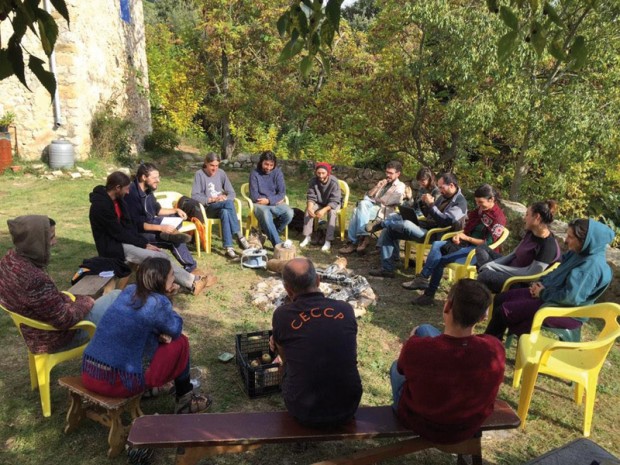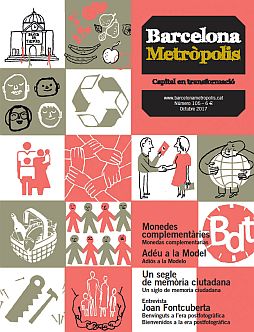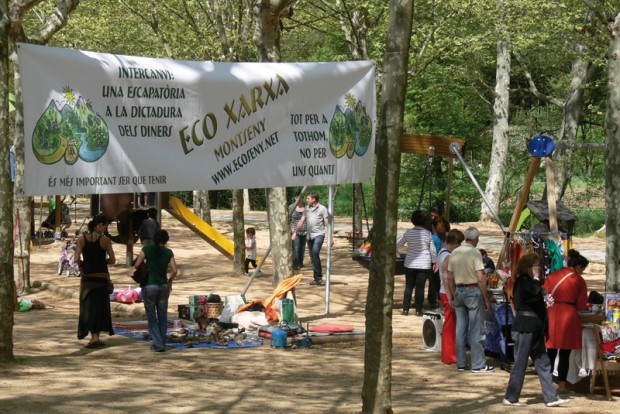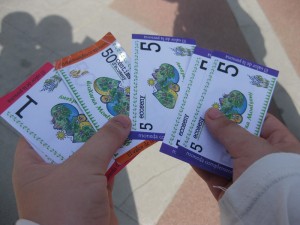The first eco-networks appeared in Catalonia around 2009-2010. These innovative initiatives entailed the use of local currencies, which in turn promoted economic transactions operating outside the dominant monetary system. They are not-for-profit networks of citizens who exchange goods and services that are paid for in social currency.
The first eco-network appeared in Montseny in January 2009, and the local currency was the ecoseny. After a year, the initiative already had three hundred users, an eco-food shop and quarterly trade fairs. Many exchanges involved the use of physical ecoseny notes. That same year the Tarragona Eco-Network and the Osona Eco-Network were also founded. They followed the same model, but had their own particular characteristics. For example, vegetarianism was one of the Montseny Eco-Network’s main focal areas, but it was not so within the Osona network.
A small local currency seminar was held in late 2009 and proved to be highly influential in terms of bringing together ideas and methodologies, as well as establishing permanent work networks amongst the different exchange networks. Also participating at this event were networks such as Xaingra, academics and social currency activists who would go on to launch the turuta currency in Vilanova and the Cooperativa Integral Catalana (the Catalan Integral Cooperative). Since then, about twenty eco-networks have emerged, each with its own dynamics and characteristics
The founding of the Cooperativa Integral Catalana (CIC) in 2010 contributed fundamental tools for the strengthening and integration of eco-networks as well as helping to start up other networks and projects. Some three thousand people in Catalonia now participate directly in a more human and greener economy through eco-networks and the CIC. Many others, while not partners, make use of their tools. Some eco-networks have experienced decline in recent years. Amongst them is the Montseny network, which presently organises few activities. It has nevertheless achieved its main mission: to serve as an example that has been replicated in other regions. Others have flourished and become stronger, generating new ideas and tools in the process.
Set up as an association, from the time it was founded the Montseny Eco-Network combined a social currency system modelled on LETS (the British “Local Exchange Trading System”) with one based on exchanging of the official currency (the euro) for the local currency (the ecoseny), similar to the system used within Germany’s regional currency movement or the “Transition Town” movement.
The possibility of currency exchanges and the collective management of the euros entering the network enable the appearance of a new kind of entity which is similar to a consumer cooperative. In the case of the Montseny network, it was called the Central de Compres Col·lectives (Collective Purchase Centre; CCC). Let us now look at how the entire system works.
As with any LETS system, users start with a balance of 0 and obtain social currency by offering goods or services. Whoever offers such goods will see their account grow as they become providers within the network, while those who receive goods or services will see their accounts reduced in size. Those who have not offered anything to the exchange will find their initial balance in the red, with an indebtedness of up to -100 at the beginning, which can grow to -500 as they obtain goods and services.
From the euro to the collective euro
From the time it started, the Montseny Eco-Network offered the possibility of obtaining local currency by changing euros for ecosenys at a 1:1 ratio. This enables the participation of both network users, or prosumers (those who produce and consume), as well as visitors or consumers who may not want to join the network, but who sympathise with it or want to make one-off purchases at fairs or when visiting a pantry (eco-network shop), without having brought anything to exchange. As euros cannot be used at the fair or the pantry, exchanges are made at an information desk, after which products can be bought.
Euros that are fed into the system become part of a new economic space, that of collective euros. While they will remain as euros – a currency that is not accepted in social currency networks – they are no longer private or personal as they acquire collective status. Unlike other networks that are based on currency exchange, this capital is not stored in banks in a way that would enable consumers to recover it in euros, nor is it used for microcredits. It is rather used for collective purchases of basic and everyday consumption products that have not yet appeared in the network. The collective purchases of basic foods are then distributed entirely in social currency via fairs and pantries to network users and visitors.
This system enables the inclusion of nearby organic external producers into the system, who are partially (from 10%) or completely paid using these collective euros. It also enables the inclusion through these producers of products that are not yet fully available using social currency. Users also supply pantries with items such as fruit or vegetables from their family gardens, or other products that the users themselves have made such as bread, biscuits, etc.
Thus, eco-networks go from being an exchange network to something akin to a consumer cooperative that has collective rather than individual accounts for both producers and consumers. This system makes it possible for social currency to be used for the purchase of products that are generally not found in traditional exchange networks, such as basic foods that can only be purchased in euros, hence reducing family expenses. And these products are obtained at reduced prices due to the practice of making collective purchases directly from producers. This shows that ecological products can be competitive when they are commercialised within an ecological monetary and distribution model.
This encourages users to strive to offer useful and interesting goods and services that will earn them social currency. The greater variety of products also attracts new consumers, which ensures an influx of euros that strengthens the network and expands the range of products.
Unlike networks in which the only way to obtain social currency is through the exchange of euros – a situation which could reproduce the economic inequalities inherent to the world of the euro – people with limited resources may participate in eco-networks under equal conditions, as while they may be unemployed or retired, they have more time to offer goods and services.
Organisation of eco-networks
Eco-networks are organised through an assembly and by different working groups making use of virtual exchange and communication tools. Their basic computer tool is Integral CES, their own version of the free online exchange CES (Community Exchange Systems) application, which originated in South Africa and is used by more than a thousand networks worldwide.
In addition, they usually own or have access to physical spaces where they can hold events such as fairs, set up organic shops and carry out currency exchanges.
Since their beginnings, eco-networks have held monthly or quarterly fairs in squares and parks, although the frequency of these events has been progressively decreasing. The existence of the first eco-networks depended on these events, while newer eco-networks view them as complementary activities. Regularly held fairs are necessary not only for effective publicity but as a means of reinforcing the user base, as over time many users end up moving to other regions or leaving the network. The ideal minimum number of users is fifty (although the more the better) to favour the diversity of goods and services, and because only a third or a quarter of all users are normally active.
Finally, the proper functioning of any exchange network requires rigorous protocols for the issuance of social currency and regular reviews of personal accounts in order to eliminate those that remain inactive for long periods and to support the kind of peer supervision that helps prevent abuses.

Fiftieth Assembly Session of the Cooperativa Integral Catalana (CIC, Catalan Integral Cooperative), held at Mas Malleu, Alta Garrotxa, in November 2014.
Photo: Cooperativa Integral Catalana
The Cooperativa Integral Catalana (CIC)
This type of entity can be defined as a network of people and projects that are organised in joint fashion with the aim of building an alternative economic model. It aims to expand more cooperative and less monetised spaces with the help of community-based models for living and working, while recognising the need to deal with the part of our economy that is in euros in a collective way and based on criteria of social economics, fair trade and sustainability.
In these communities you can live well on a monthly income of €300 or €400, to which another 100 or 200 ecos may be added. Communities may also self-manage a portion of their food supply by growing orchards or fruit trees and arrange housing under a cooperative right-of-use system. This creates a new focal point from which employment alternatives may be explored in a context where unemployment and urban housing difficulties are on the rise.
The CIC collectively protects users from external regulations and provides a space where internal producers can sell their products to other internal users and producers using social currency and in euros without being subjected to many of the legal procedures that are required when selling in the capitalist market. It also collectively resolves legal, taxation and administrative issues while streamlining the creation of work or housing cooperatives, etc.
From its beginnings, the CIC has looked to social currencies as a decisive tool for social change. It showed interest in the Montseny Eco-Network and in reproducing and improving the network model through the introduction of the first eco-shop and the promotion of the Barcelona Eco-Network in the Gràcia district. This network was never established, but its meetings served to strengthen the CIC, which has in turn greatly helped eco-networks through initiatives such as purchasing goods that require higher levels of investment. The CIC has helped to initiate and strengthen many proposals for cooperative and occupational housing by providing initial structures, legal bodies, a large network of support mechanisms and tools, and in some cases start-up financing.
Some of the most important of the CIC’s structures include the (Cooperativa d’Autofinançament Social en Xarxa [Cooperative for Networked Social Self-Financing]; CASX), an alternative bank operating in euros which offers interest-free project financing; the CoopFunding platform, which finances cooperative projects; and in particular the Central d’Abastiment Catalana (Catalan Supply Centre; CAC), a food distribution network that purchases goods from producers throughout Catalonia partially in social currency and partially in euros and distributes them to the entire CIC network and to related projects.
Eco-networks are paying the CAC in ever-higher percentages of social currency instead of in euros. The CAC’s economy is organised around a circular cash flow circuit in euros. Suppliers may nonetheless pay in variable ratios of social currency and euros as a means of facilitating access to the European currency – which is needed to cover expenses such as rents, petrol, etc. – without the need to abandon the alternative financial system.
One of the founders of the CIC, which has been partially replicated in many other Spanish communities, was Enric Duran, a Catalan activist known for having organised a civil disobedience protest against the banking system. He took out loans of up to a half a million euros from 17 banks and distributed the funds to social movements a year before the CIC and the eco-networks were launched. Today his whereabouts are unknown, as he is wanted by the authorities for his actions. He was also the main driving force, albeit whilst in hiding, behind the FairCoop initiative.

Poster for the campaign in support of Enric Duran, promoter of the CIC and of Fair Coop, who in 2013 went underground as he was being sought by the courts for having taken out loans from banks which he handed over to social movements.
The FairCoop cooperative system
In 2015, members of the CIC, the P2P Foundation and groups of hacker activists joined forces to create FairCoop, an alternative cooperative banking network which elevated some of the ideas and work of integral cooperatives to the world stage. It includes the use of P2P currencies such as FairCoin, which is similar to Bitcoin but more geared towards social and cooperative use.
FairCoop offers organisational and legal support to alter-capitalist initiatives by means of an open cooperative which is self-organised via the internet and uses certain legal and fiscal mechanisms to operate outside state financial and taxation control. It lowers the taxes on exchanges between members and distributes the financial resources created through these tax savings to projects.
Grass-roots and counter-culture movements that work in a self-managed and associative way – in addition to immigrants, refugees, precarious workers and cooperatives – can use the services of FairCoop to reduce their tax and administrative expenses, create bank accounts to receive external payments or pay suppliers and customers, manage projects outside the control of the financial system, organise tax disobedience actions and receive legal protection in the event of personal insolvency without the risk of having their accounts blocked.
Freedom Coop is the legal tool available at European level that the projects linked to FairCoop can use to organise their legal and financial activities without the need to be registered in each country. It is also used by other projects founded by the same organisation such as FairCoin, FairMarket (an online marketplace that unites hundreds of members from around the world and provides access to many products), CoopFunding, FairSavings, CoopShares and FairCredit.
As in the case of Bitcoin, FairCoin is possible thanks to Blockchain, a new tool which analysts such as Don Tapscott say will lead the next internet revolution. It allows for the complete decentralisation of our societies – with total security regarding the registration of accounts, votes, etc. – to make them more democratic. Hervé Falciani publicly declared his support for FairCoin and applauded the fact that social P2P currencies are one of the few ways of escaping the power of the economic elite in our societies.





